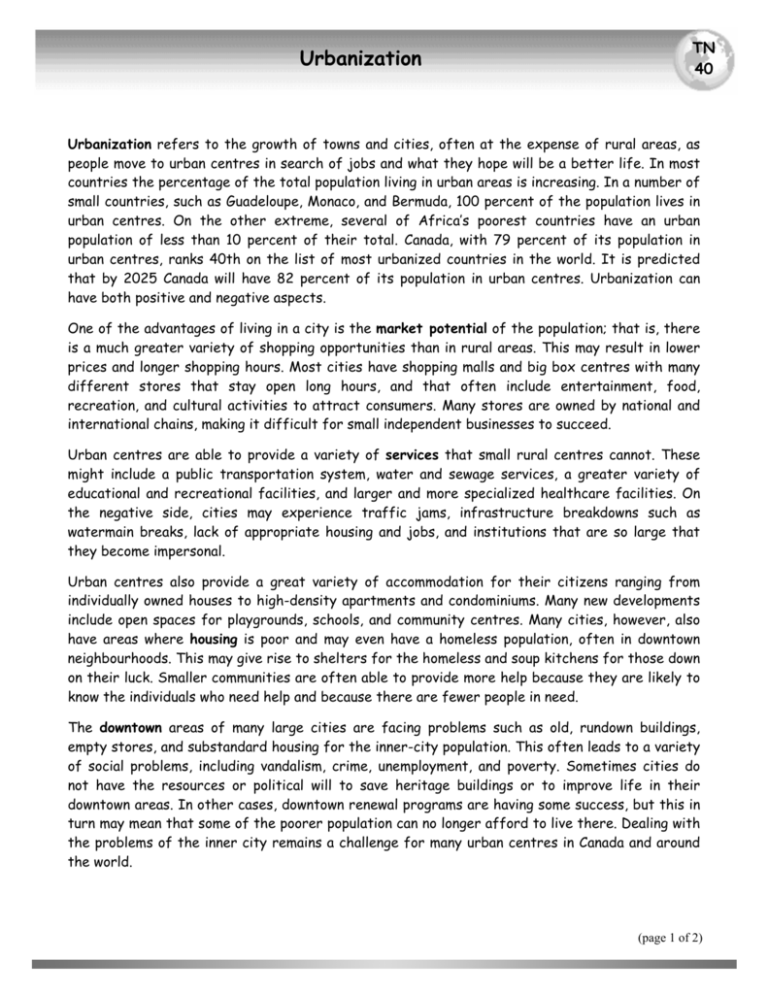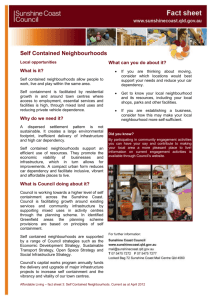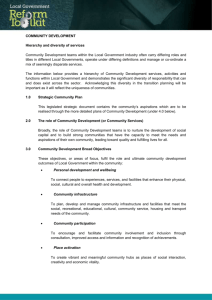Urbanization
advertisement

Antiti Urbanization TN 40 Urbanization refers to the growth of towns and cities, often at the expense of rural areas, as people move to urban centres in search of jobs and what they hope will be a better life. In most countries the percentage of the total population living in urban areas is increasing. In a number of small countries, such as Guadeloupe, Monaco, and Bermuda, 100 percent of the population lives in urban centres. On the other extreme, several of Africa’s poorest countries have an urban population of less than 10 percent of their total. Canada, with 79 percent of its population in urban centres, ranks 40th on the list of most urbanized countries in the world. It is predicted that by 2025 Canada will have 82 percent of its population in urban centres. Urbanization can have both positive and negative aspects. One of the advantages of living in a city is the market potential of the population; that is, there is a much greater variety of shopping opportunities than in rural areas. This may result in lower prices and longer shopping hours. Most cities have shopping malls and big box centres with many different stores that stay open long hours, and that often include entertainment, food, recreation, and cultural activities to attract consumers. Many stores are owned by national and international chains, making it difficult for small independent businesses to succeed. Urban centres are able to provide a variety of services that small rural centres cannot. These might include a public transportation system, water and sewage services, a greater variety of educational and recreational facilities, and larger and more specialized healthcare facilities. On the negative side, cities may experience traffic jams, infrastructure breakdowns such as watermain breaks, lack of appropriate housing and jobs, and institutions that are so large that they become impersonal. Urban centres also provide a great variety of accommodation for their citizens ranging from individually owned houses to high-density apartments and condominiums. Many new developments include open spaces for playgrounds, schools, and community centres. Many cities, however, also have areas where housing is poor and may even have a homeless population, often in downtown neighbourhoods. This may give rise to shelters for the homeless and soup kitchens for those down on their luck. Smaller communities are often able to provide more help because they are likely to know the individuals who need help and because there are fewer people in need. The downtown areas of many large cities are facing problems such as old, rundown buildings, empty stores, and substandard housing for the inner-city population. This often leads to a variety of social problems, including vandalism, crime, unemployment, and poverty. Sometimes cities do not have the resources or political will to save heritage buildings or to improve life in their downtown areas. In other cases, downtown renewal programs are having some success, but this in turn may mean that some of the poorer population can no longer afford to live there. Dealing with the problems of the inner city remains a challenge for many urban centres in Canada and around the world. (page 1 of 2) Antiti Urbanization TN 40 Rapid growth of urban centres can lead to urban sprawl, where new subdivisions are developed around the outer edges of urban centres, often taking up valuable farmland. Many residents want larger houses, more space, and quieter and safer neighbourhoods, which they find in the new suburban developments far removed from the inner core of the city. This kind of growth requires the expansion of utilities and the road network, as well as the provision of services such as schools, recreation, health care, and retail business. The growth of suburbs also leads to increased reliance on automobiles for commuting to work, resulting in frequent traffic problems as well as air pollution through the heavy reliance of fossil fuels. In the case of many less-developed countries, cities are simply not able to handle the influx of residents, which may result in the growth of shantytowns and large suburban slum areas with a variety of associated problems. Industrial and manufacturing industries are associated with most cities. The presence of such industries can provide cities with locally produced consumer products, employment opportunities, and extra tax revenues. On the other hand, the presence of industry and manufacturing can add to problems related to transportation and water and air quality in urban centres. Many major urban centres have areas with a large number of residents of a particular ethnic or cultural group. Sometimes referred to as ethnic neighbourhoods, these places often reflect the cultures, foods, institutions, and entertainment of the people who live there. A number of Canadian cities, for example, have a “Chinatown,” a “Little Italy,” and other cultural-based communities that reflect our multicultural population. Historically, many Canadian immigrants who lived in these neighbourhoods were poorly treated and subject to racism and discrimination by the general population. Today, however, through Canada’s official policy of multiculturalism, education, and many special community events, the presence of cultural groups is widely celebrated as part of our rich diversity. Urbanization is a fact of life in most cities in Canada and around the world. Although urbanization is accompanied by many problems and challenges, many city governments are working hard at minimizing and resolving these problems and at making their cities pleasant and comfortable places to live. (page 2 of 2)









